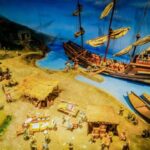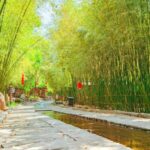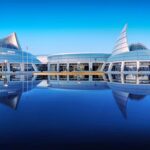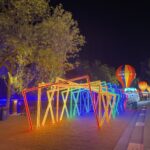Ningbo Museum is located near Yinzhou Park. Although the museum does not house particularly rare cultural relics, it offers comprehensive exhibitions on the history and folklore of Ningbo, providing visitors with a glimpse into the city’s past. Additionally, the museum building itself is a piece of ‘exhibition’, featuring a distinctive design that attracts many architecture enthusiasts. Designed by architect Wang Shu, the exterior walls incorporate a large number of old bricks and tiles from traditional Ningbo buildings, some of which are slanted. Upon closer inspection, one can even discover symbols left from the original firing process on these bricks and tiles. Surrounded by lotus ponds and reed beds, the museum is both modern and steeped in traditional charm. The exhibition halls are divided into three levels: the first floor features temporary special exhibitions, which may require additional tickets for entry; the second and third floors offer free regular exhibitions. The second floor houses the thematic display ‘Oriental Divine Vessel – Ningbo Historical Exhibition’, which is the museum’s main attraction. The exhibition in four halls narrates the history of Ningbo from ancient times to the establishment of the city, through to its development as an international port and a major city in the southeast. Here, you can see wax figure recreations of Hemudu living scenes, unearthed Yue ware porcelain, and restored scenes of Jiangxia Street and trade. This allows for a systematic understanding of Ningbo’s development from ancient times to the present, making it worth a careful visit. The third floor is dedicated to bamboo carving and Ningbo’s folk customs. The ‘Ala’ Old Ningbo Folk Customs Exhibition is more vivid than the second floor’s displays. Walking through the exhibition, visitors can stroll through restored old Ningbo streets, view the old city walls lining the streets, and see displays of traditional handicrafts, as if transported back to the streets of Ningbo in the last century. Exiting the folk customs exhibition hall leads to a terrace where visitors can rest after a long walk before proceeding to the bamboo carving exhibition. Opening hours are Tuesday to Friday from 09:00 to 17:00; closed all day on Mondays; and open from 09:00 to 21:00 on Saturdays and Sundays. Service facilities include a parking lot and luggage storage (free of charge); valuables should be kept with you. Guided tours are available: 1. Chinese language讲解1-10 people/30 yuan, 11-20 people/50 yuan, over 21 people/30 yuan. 2. Foreign language讲解(English, Japanese, French, German)1-10 people/50 yuan, 11-20 people/80 yuan, over 21 people/120 yuan. The讲解 covers only the second floor’s thematic display, lasting approximately 1 hour. Full museum讲解, double the fee, lasts about 2 hours. Please note: 1. Reservations should be made with a confirmed visit time to facilitate scheduling for other visitors. 2. In case of special circumstances, the museum will notify visitors in advance to arrange alternative讲解 or visit times.
Audio Guide Rentals: Audio tours are available for free, featuring narrations in Chinese, English, Japanese, and Korean. Users must present valid identification for on-site registration. The maximum number of devices per use is 10, with a usage period of 1.5 hours. Any loss or damage will be compensated at the original price.
Restrooms: Refer to the tour map for must-see tips. 1. Please do not touch exhibits within the exhibition halls; the use of tripods and flash photography is prohibited when photographing (or filming) cultural relics. 2. Paid guides are available within the museum, and audio guides can also be rented.








